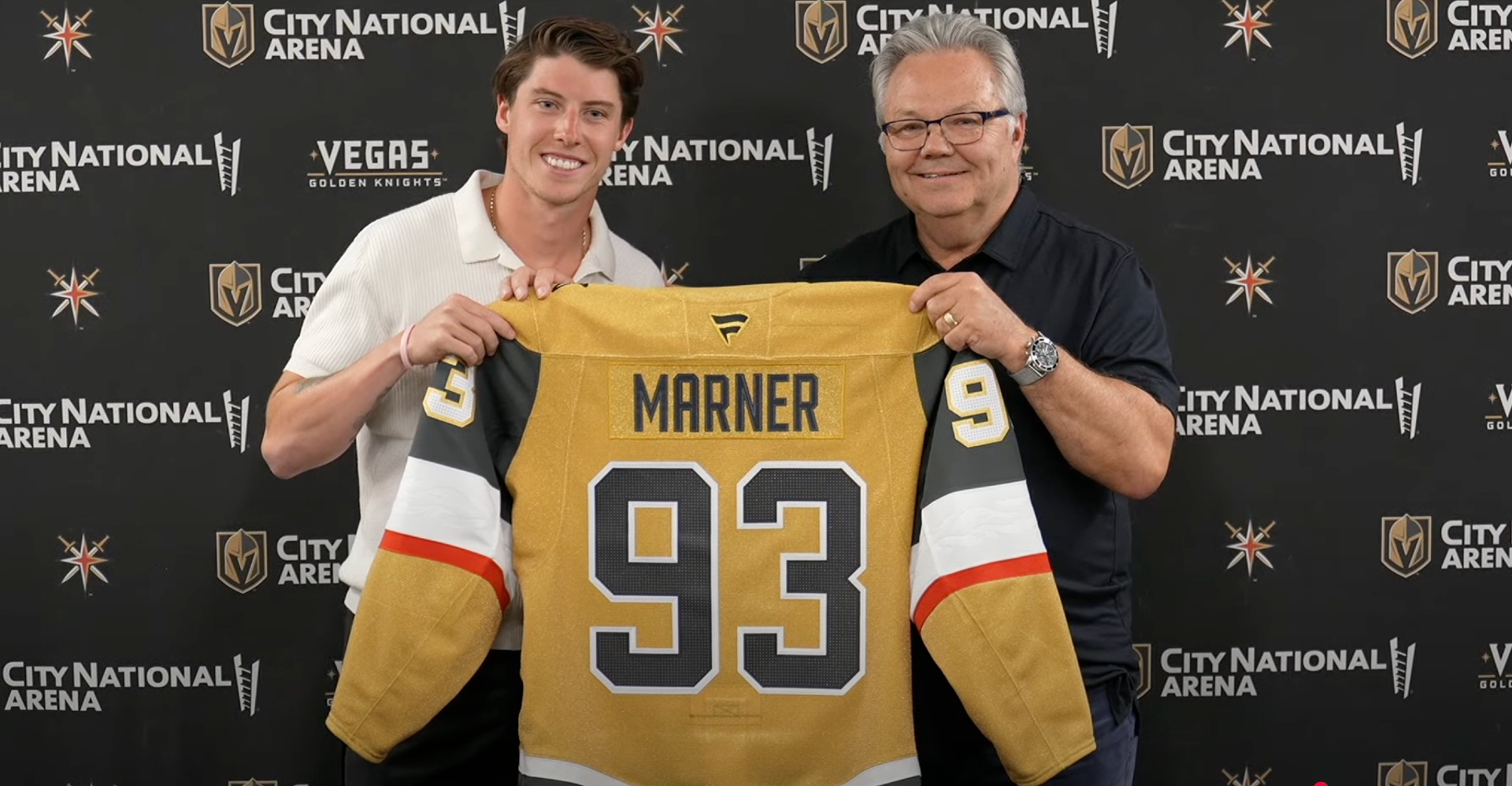Mitch Marner has officially moved on to pastures new, and all that’s left are the media eulogies of his Maple Leafs tenure and what could’ve been.
Before we officially turn the page to the rest of the offseason/the organization’s future moving forward, I wanted to address a few of the narratives I’ve come across that, in my view, miss the mark.
Narrative #1: The Leafs should’ve signed Marner to 8×8 earlier
History might have played out much differently had the team and its GM somehow latched Marner onto something like an eight-year deal with an $8 million cap hit.
The Leafs might have kept Hyman after all in the summer of 2021. And maybe, with roughly $3 million extra to spare, they could have deepened their forward group and/or upgraded the back end in a more substantial way.
Marner would have been a hero in that world; the star who was underpaid, the star who took less — something Shanahan once insisted would be expected of players in Toronto. Pressure might have been lifted. Maybe the playoff failures would have been a different story.
In that alternate reality, Marner would still have time remaining on his contract today.
– Jonas Siegel
This is a counterfactual and peak 20-20 hindsight, but more than that, it ignores that there was still absolutely no basis for Marner earning a hair shy of $11 million AAV over six years on his second contract, even after the expiry of his entry-level deal (as I criticized at the time).
Here were Mikko Rantanen’s two platform ELC seasons in Colorado before he signed his 9.25×6 deal with the Avs (signed the same summer as Marner’s):
| Season | GP | G | A | Pts |
|---|---|---|---|---|
| 2017-18 | 81 | 29 | 55 | 84 |
| 2018-19 | 74 | 31 | 56 | 87 |
Rantanen also produced six goals and 14 points in 12 games in the postseason preceding the signing.
So why did the Leafs pay a $2 million premium for Marner? Egos. Internal politics. A “player-friendly” GM who had no appetite to go through the wringer with Marner as he previously did Nylander (with some challenging cap dynamics adding pressure on the club side).
The 8×8 what-if, assuming Marner’s camp would’ve entertained it at the time (a big assumption), shouldn’t have been all that relevant because the end result of learning whether Marner was worth the money by the end of his ELC should’ve been 6x9ish.
Narrative #2: Mitch Marner, finally unleashed!
Hockey-wise, it’s a perfect fit. The Knights weren’t dangerous enough off the wing last season; his arrival addresses that. He will thrive in Nevada, rise to another level.
– Elliotte Friedman
Full marks to Elliotte Friedman for being the authoritative, trustworthy source on the Marner sign-and-trade saga. But I’m skeptical of this “look out now!” notion wherein we’re expecting to see Marner unleashed in Vegas. He’ll remain a highly productive player on a good team, but in what way was his success hindered in Toronto? Are we saying fan/media pressure limited him to 102 points instead of 110?
In Toronto, Marner was among the exclusive few who averaged more than 21 minutes per night as a forward over the past three regular seasons and over 22 in the playoffs. When Auston Matthews was healthy and in the lineup, Marner — an elite pass-first player — played 70+% of his all-situations minutes in the last three seasons with the best triggerman of his generation, largely through thick and thin. Marner somehow scored one goal in his last 230 minutes of playoff power-play time (seems almost impossible to do) and yet never once was he moved off the top unit, even just for a different look more than an outright punishment/demotion. Even in the games when he was visibly wilting under the pressure, Marner played a boatload of all-situations minutes.
Some fans can be nuts, sure, but Marner had it good in Toronto. Unfortunately, when the chips were down, Marner really didn’t deliver for the GMs, coaches, and teammates that showed a ton of faith in his abilities; zero goals and five points in 16 games from games 5-7 in the playoffs, one goal in his last 230 playoff power-play minutes, and just eight goals in his last 50 playoff games overall.
That doesn’t mean he can’t improve those numbers in a different team dynamic with several teammates who have already won a Cup together, but it had run its course in Toronto.
Narrative #3: Marner, a victim of the Toronto market
Social media criticism is now an unavoidable part of life for a high-profile pro athlete. A lot of it is fair game. There have been unacceptable, over-the-line comments made toward Marner online (and possibly a few in person) by some unhinged individuals, and 99% of people in the market would flatly condemn this behaviour. But is Marner the only one on the team or in the sports scene in Toronto to deal with the crazies as a high-profile public figure? It’s an unfortunate part of (an otherwise fabulous) life as a professional athlete playing for a big-market franchise. Others can tune out the noise.
[For what it’s worth, which isn’t much in this case, among the many — usually more casual — Leafs fans I’ve interacted with over the years, I often heard a lot more love than hate for Marner, particularly among older Leafs fans, and even many debates that he is their actual best player, not Matthews. But that could just be my own experience.]
On the ice, Marner struggled to adapt to the north-south, crash-the-net requirements for generating offense against high-end defensive teams inside the toughest matchups in the playoffs. This remained the case over and over again. As the playoff failures and pressure to deliver mounted, it only seemed to get worse as he struggled to handle the stakes and appeared to have the yips at times in the biggest, series-deciding moments. Instead of just stating this plainly obvious truth about Marner’s play in the playoffs over and over again, we needed fresh angles and explanations for the same old playoff results, and some in the media fell back on the tired, age-old “is it actually the fans’ fault?” narrative.
This is my own view on the outside looking in at people I don’t know personally, so forgive me for a moment: I always felt there was a disconnect between the way Marner’s camp handled their business and Marner’s personality, at least through knowing what we know of Marner as a more sensitive individual who lived inside the market 24/7/365.
For some personalities, it’s really not worth flopping your you-know-what on the table and milking every cent you can get through protracted, publicly-debated contract negotiations (just an easy example of many, someone like Morgan Rielly, who prefers to keep his head down, really seems to get this). William Nylander has the unique personality to command everything he can possibly get at contract time, even if he’s sitting through holdouts to get it, and not really be affected; in fact, a little extra heat seems to fuel Nylander, if anything. Marner has always come across as a very different type of personality.
These last five years could’ve been much different if there had never been any stink about contracts and he made a little less (I am not arguing for a big sweetheart discount — players have to get theirs — but just something sensible in line with his peers based on the ELC production). Marner just signed a ~100 million contract after already earning nearly $70 million; he wouldn’t have missed the money, and his life on and off the ice would’ve run smoother for him. Of course, every bit of cap space under the previously flat cap would’ve helped the team’s cause of building a Cup winner, which would’ve been great for everyone long term, financially and otherwise (especially in a market like Toronto, where we make heroes out of Conference Finals appearances, and a retired Darcy Tucker is employed as a club ambassador/brand ambassador for several businesses. We’ll say it until we’re blue in the face, but the bar is not impossibly high to clear here).
It’s also fair to point out that, as much as some in the media want to portray Marner as a victim of the market, his own camp eagerly drummed up the mania of the Toronto fan and media environment to its own financial benefit at contract time in 2019. Can’t have it both ways.
And so Marner is gone. It’s a real shame it turned out this way for all parties involved, given the potential of the Leafs’ Cup aspirations during his tenure and Marner’s potential legacy as a hometown legend. But he’s no victim, and a change of scenery became unavoidable/seemingly for the best for both parties.
Best of luck in Vegas, Mitch.















![John Gruden after the Leafs prospects’ 4-1 win over Montreal: “[Vyacheslav Peksa] looked really comfortable in the net… We wouldn’t have won without him” John Gruden, head coach of the Toronto Marlies](https://mapleleafshotstove.com/wp-content/uploads/2025/09/gruden-post-game-sep-14-218x150.jpg)


















